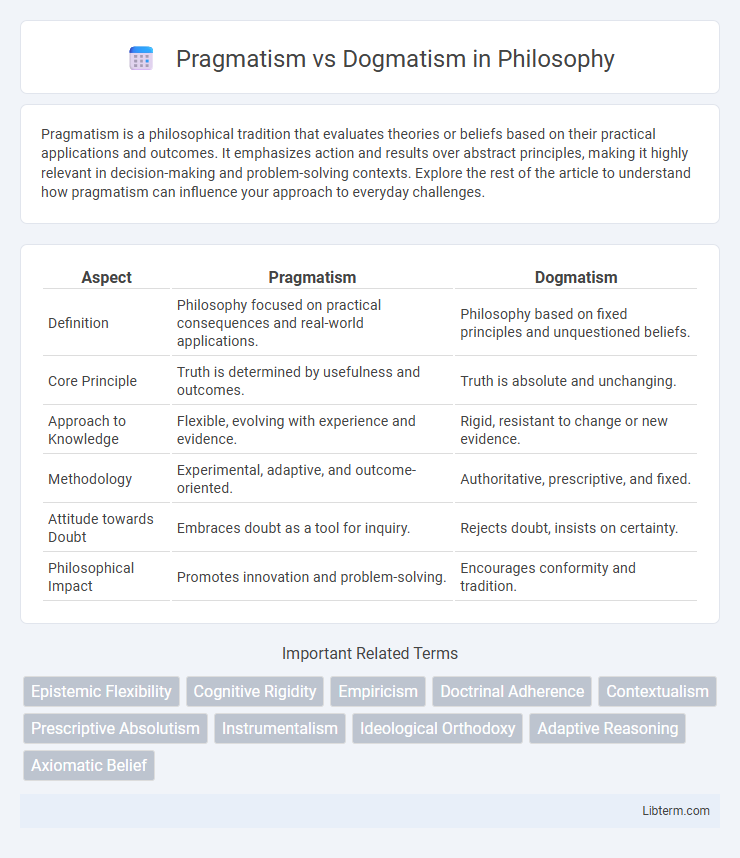Pragmatism is a philosophical tradition that evaluates theories or beliefs based on their practical applications and outcomes. It emphasizes action and results over abstract principles, making it highly relevant in decision-making and problem-solving contexts. Explore the rest of the article to understand how pragmatism can influence your approach to everyday challenges.
Table of Comparison
| Aspect | Pragmatism | Dogmatism |
|---|---|---|
| Definition | Philosophy focused on practical consequences and real-world applications. | Philosophy based on fixed principles and unquestioned beliefs. |
| Core Principle | Truth is determined by usefulness and outcomes. | Truth is absolute and unchanging. |
| Approach to Knowledge | Flexible, evolving with experience and evidence. | Rigid, resistant to change or new evidence. |
| Methodology | Experimental, adaptive, and outcome-oriented. | Authoritative, prescriptive, and fixed. |
| Attitude towards Doubt | Embraces doubt as a tool for inquiry. | Rejects doubt, insists on certainty. |
| Philosophical Impact | Promotes innovation and problem-solving. | Encourages conformity and tradition. |
Understanding Pragmatism: An Overview
Pragmatism emphasizes practical consequences and real-world applications as the primary criteria for meaning and truth, contrasting sharply with the rigid, absolute principles upheld by dogmatism. It advocates flexible thinking and continuous adaptation based on experiential learning and problem-solving effectiveness. Key figures such as Charles Sanders Peirce, William James, and John Dewey have shaped pragmatism's focus on ideas as instruments for action rather than fixed doctrines.
Defining Dogmatism: Core Concepts
Dogmatism refers to an unwavering adherence to established beliefs or doctrines without consideration of alternative viewpoints. Core concepts include inflexibility, a closed-minded stance, and resistance to evidence that contradicts held convictions. This rigid mindset often limits critical thinking and hinders open dialogue essential for intellectual growth.
Historical Roots of Pragmatism and Dogmatism
Pragmatism originated in the late 19th century with philosophers like Charles Sanders Peirce and William James, emphasizing practical consequences and experiential learning as the basis for truth. Dogmatism, with roots in ancient Greek philosophy and medieval scholasticism, rigidly adheres to established doctrines and authoritative principles regardless of new evidence. The historical development of pragmatism reflects a shift toward flexibility and adaptability, contrasting sharply with dogmatism's tradition of unwavering certainty.
Key Differences Between Pragmatism and Dogmatism
Pragmatism emphasizes practical outcomes and flexibility in beliefs, prioritizing evidence and results over rigid adherence to fixed principles. Dogmatism insists on unwavering commitment to established doctrines or beliefs, often resisting change despite contradictory evidence. The key difference lies in pragmatism's adaptability and openness to revising views based on experience, whereas dogmatism relies on certainty and absolute principles regardless of new information.
Impact on Decision-Making Processes
Pragmatism enhances decision-making processes by promoting flexibility, evidence-based evaluation, and adaptation to changing circumstances, leading to practical and effective solutions. Dogmatism, conversely, restricts decision-making by adhering rigidly to established beliefs or doctrines, often resulting in resistance to new information and suboptimal outcomes. The impact on organizational and personal decisions is significant, as pragmatism fosters innovation and responsiveness, while dogmatism may cause stagnation and conflict.
Pragmatism in Modern Society
Pragmatism in modern society emphasizes practical solutions, adaptability, and results-driven approaches that address contemporary challenges efficiently. It promotes open-mindedness and continuous learning, valuing evidence and experience over rigid beliefs or ideologies. This mindset fosters innovation and collaboration across diverse fields such as technology, education, and governance.
Dogmatism in Contemporary Thought
Dogmatism in contemporary thought often manifests as rigid adherence to established beliefs or ideologies despite contrary evidence, limiting intellectual flexibility and critical inquiry. This inflexibility can hinder adaptation in rapidly changing social, political, and scientific landscapes, reducing openness to alternative perspectives. Contemporary critiques emphasize the need to balance dogmatic convictions with pragmatic considerations that encourage evidence-based reasoning and adaptive problem-solving.
Advantages and Drawbacks of Each Approach
Pragmatism emphasizes practical outcomes and adaptability, allowing flexible problem-solving but may overlook consistent principles or long-term ideals. Dogmatism provides clarity and strong conviction, fostering decisive action and ideological stability, yet risks rigidity and resistance to new evidence or alternative perspectives. Balancing pragmatism's flexibility with dogmatism's steadfastness can optimize decision-making in dynamic and complex environments.
Pragmatism vs Dogmatism in Education
Pragmatism in education emphasizes experiential learning, critical thinking, and adaptability to real-world problems, fostering skills that prepare students for dynamic environments. Dogmatism in education prioritizes rigid adherence to established doctrines and fixed curricula, often limiting creativity and discouraging questioning. Pragmatic approaches encourage continuous inquiry and practical application, enhancing student engagement and lifelong learning.
Moving Toward a Balanced Perspective
Pragmatism emphasizes practical solutions and adaptability, while dogmatism relies on rigid adherence to established beliefs or doctrines. Moving toward a balanced perspective involves integrating the flexibility of pragmatism with the clarity and commitment found in dogmatism, fostering open-mindedness without sacrificing core principles. This approach enhances decision-making by encouraging critical evaluation and contextual responsiveness in complex situations.
Pragmatism Infographic

 libterm.com
libterm.com